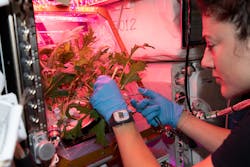Meanwhile in space, astronaut tinkers with horticultural lighting
With industry in an unprecedented slowdown on Earth, LEDs Magazine went looking elsewhere for lighting activity. Lo and behold we found it, about 220 miles above the planet, where at least one astronaut yesterday was chancing her hand at horticultural lighting on the International Space Station.
“Flight Engineer Jessica Meir of NASA spent a couple of hours on botany research learning how to cultivate vegetables and fruits in space,” blogger Mark Garcia reported in a daily Space Station update on the NASA website.
We don’t know exactly what tasks Meir performed, or whether she adjusted any of the lights aimed at the vegetables growing in the yonder. But we do know that she was dabbling in the space station’s Veggie PONDS (Passive Orbital Nutrient Delivery System) project.
Veggie PONDS aspires to learn more about how to grow food in space in order to help sustain crew on future and longer missions.
The International Space Station (ISS) is currently testing the growth of mizuna mustard greens and red romaine lettuce, studying lighting as well as other aspects including the growth media.
“The Veggie facility is activated with the desired photoperiod, light levels, and fan speed programmed via the control panel” and also utilizes a mechanism called a “Veggie Lightcap,” NASA said on a Veggie PONDS web page.
PONDS builds on earlier work by NASA land lubbers, including those at Florida’s Kennedy Space Center who were experimenting with a multichannel LED system that combined phosphor-converted white LEDs, monochromatic red and blue LEDs, and ultraviolet (UV) LEDs.
“The Veggie PONDS investigation expands on previous validation tests of the new Veggie hardware, which can potentially allow crew members to grow a variety new crops from new leafy greens to dwarf fruit crops in space,” NASA said. “Tests also aim to determine and monitor microbiome population changes that are present in space-grown crops, providing baseline data for future food production efforts.”
Like most ISS experiments, Veggie PONDS could have ramifications for earthlings.
“Results from the Veggie PONDS investigation contribute to basic research on plant cultivation, benefiting agricultural and biomass production efforts on Earth,” NASA notes. “The technology used in the Veggie crop production system could be adapted for use in areas from roof top gardens in densely populated areas where there is little room for growing plants, to horticultural therapy for individuals who would otherwise be unable to enjoy a garden.”
For astronaut Meir, yesterday was not her first close encounter with the onboard horticultural lighting. On an earlier mission last October, she cultivated and ate greens that were part of the ISS’s “ VEG-04B” agricultural study, according to a NASA Flickr page (see photo).
She also spent parts of yesterday monitoring her arteries during exercise, photographing gut microbes, and unpacking samples of materials that had been exposed to the harsh environment outside the ISS, according to blogger Garcia.
All in a day’s work at 220 miles high.
MARK HALPER is a contributing editor for LEDs Magazine, and an energy, technology, and business journalist ([email protected]).

Mark Halper | Contributing Editor, LEDs Magazine, and Business/Energy/Technology Journalist
Mark Halper is a freelance business, technology, and science journalist who covers everything from media moguls to subatomic particles. Halper has written from locations around the world for TIME Magazine, Fortune, Forbes, the New York Times, the Financial Times, the Guardian, CBS, Wired, and many others. A US citizen living in Britain, he cut his journalism teeth cutting and pasting copy for an English-language daily newspaper in Mexico City. Halper has a BA in history from Cornell University.





